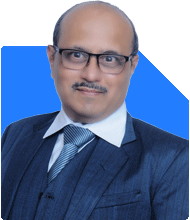37-Year-Old Woman Seeks Advice: Can She Achieve a Rs.2 Crore Corpus in 10-20 Years with Her Current Investments?
Ramalingam Kalirajan |10894 Answers |Ask -Follow
Mutual Funds, Financial Planning Expert - Answered on Aug 12, 2024
He has an MBA in finance from the University of Madras and is a certified financial planner.
He is the director and chief financial planner at Holistic Investment, a Chennai-based firm that offers financial planning and wealth management advice.... more

Hello sir ,I am 37 years old female I am investing in mutual fund since 2023 Total value approx.2 lakh SBI contra-5000 Edelweiss balanced advantage fund -2000 Mirae asset ELSS tax saver-2000 Parag pareikh flexi cap direct growth-3000 Quant small cap -5500 Bhandhan ELSS tax saver-2500 Some investment in PPF- 8lkh Ssy-6 lkh Please advice is this a right way to achieve goal of corpus 2 crore in 10-20 years or need more investment or any changes in investment Please advice
Evaluating Your Existing Mutual Fund Portfolio
SBI Contra Fund
A contra fund invests in undervalued stocks, following a contrarian approach. These funds can deliver high returns over the long term but can be volatile. Given your long-term horizon, it’s a good addition to your portfolio, especially if you have a high-risk appetite.
Edelweiss Balanced Advantage Fund
Balanced advantage funds dynamically allocate between equity and debt based on market conditions. This fund offers stability and is suitable for conservative investors. It’s a good choice for reducing the overall risk in your portfolio.
Mirae Asset ELSS Tax Saver
ELSS funds provide tax benefits under Section 80C and have a three-year lock-in period. These funds are equity-oriented, offering growth potential. Investing in ELSS is a smart way to save taxes while building wealth.
Parag Parikh Flexi Cap Fund
Flexi-cap funds invest across large, mid, and small-cap stocks. This fund is versatile, providing diversification across different market capitalizations. It’s a strong growth-oriented fund that can help you achieve your long-term goals.
Quant Small Cap Fund
Small-cap funds invest in smaller companies with high growth potential. While these funds can be volatile, they offer significant returns over time. However, it’s crucial to monitor them closely, especially if market conditions change.
Bandhan ELSS Tax Saver Fund
Like the Mirae Asset ELSS fund, this fund also provides tax benefits while offering growth through equity investments. Having two ELSS funds can be redundant unless you are utilizing them fully for tax savings under Section 80C.
Review of Your Non-Mutual Fund Investments
Public Provident Fund (PPF)
Your investment in PPF is sound. It provides safety, guaranteed returns, and tax benefits. However, the returns are fixed and may not keep pace with inflation over the long term. It’s good for preserving capital but not for aggressive growth.
Sukanya Samriddhi Yojana (SSY)
SSY is a government-backed savings scheme for the girl child, offering a high-interest rate with tax benefits. It’s an excellent investment for long-term security and is well-suited for goals related to your daughter’s future.
Assessing Your Investment Strategy
Current Investment Amounts
You are currently investing around Rs. 19,000 per month in mutual funds. To achieve a corpus of Rs. 2 crores in 10-20 years, it’s essential to evaluate whether this amount, along with your existing investments, will be sufficient.
Required Corpus Calculation
Without going into specific calculations, a rough estimate suggests that you may need to invest more than your current amount, especially if your goal is closer to 10 years. If your horizon is 20 years, your current investments, coupled with regular increases, might be sufficient.
Need for Additional Investment
If you can increase your monthly SIP amount, it would significantly enhance your chances of reaching your Rs. 2 crore target within 10 years. Given your current investments and the potential growth of your funds, consider gradually increasing your SIPs by 10-15% annually.
Suggested Adjustments and Diversification
Portfolio Diversification
Your portfolio is diversified across different types of funds, which is good. However, the allocation could be fine-tuned for better balance:
Increase Allocation to Large-Cap Funds: Large-cap funds provide stability and consistent returns. Consider adding a large-cap fund to your portfolio or increasing allocation if you already have one.
Reduce Redundancy in ELSS Funds: Since you have two ELSS funds, you might want to consolidate into one, unless both are serving a specific tax-saving purpose.
Monitor Small-Cap Exposure: While small-cap funds offer high growth, they also come with higher risk. Ensure you are comfortable with the volatility and consider balancing this with more stable investments.
Consider Adding a Multi-Cap Fund: Multi-cap funds offer diversification across large, mid, and small-cap stocks. They balance risk and return effectively, making them a good option for long-term growth.
Regular Review and Rebalancing
Review your portfolio at least once a year to ensure it remains aligned with your goals. Rebalance if necessary, to maintain the desired asset allocation.
The Disadvantages of Direct Funds
You are currently investing in direct funds, which have a lower expense ratio. However, direct funds require active monitoring and decision-making. If you prefer a more hands-off approach, investing through a Certified Financial Planner (CFP) with a Mutual Fund Distributor (MFD) credential can offer professional guidance, regular reviews, and portfolio adjustments. This ensures that your investments remain on track with your financial goals.
Final Insights
You are on the right path with your current investments. Your diversified portfolio of mutual funds, combined with safe investments like PPF and SSY, offers a good mix of growth and stability. However, to reach your Rs. 2 crore target in 10-20 years, consider increasing your monthly SIPs and possibly reallocating some investments for better balance.
Regularly reviewing your portfolio and making necessary adjustments will help you stay on track to achieve your financial goals. With disciplined investing and strategic planning, you can build a robust corpus for your future.
Best Regards,
K. Ramalingam, MBA, CFP,
Chief Financial Planner,
www.holisticinvestment.in
You may like to see similar questions and answers below
Ramalingam Kalirajan |10894 Answers |Ask -Follow
Mutual Funds, Financial Planning Expert - Answered on May 30, 2024
Ramalingam Kalirajan |10894 Answers |Ask -Follow
Mutual Funds, Financial Planning Expert - Answered on Jun 04, 2024
Ramalingam Kalirajan |10894 Answers |Ask -Follow
Mutual Funds, Financial Planning Expert - Answered on Oct 16, 2024
Milind Vadjikar | Answer |Ask -Follow
Insurance, Stocks, MF, PF Expert - Answered on Nov 28, 2024
Ramalingam Kalirajan |10894 Answers |Ask -Follow
Mutual Funds, Financial Planning Expert - Answered on Dec 11, 2024
Patrick Dsouza |1429 Answers |Ask -Follow
CAT, XAT, CMAT, CET Expert - Answered on Dec 16, 2025
Nayagam P P |10858 Answers |Ask -Follow
Career Counsellor - Answered on Dec 16, 2025
Nayagam P P |10858 Answers |Ask -Follow
Career Counsellor - Answered on Dec 16, 2025
Samraat Jadhav |2510 Answers |Ask -Follow
Stock Market Expert - Answered on Dec 16, 2025
Samraat Jadhav |2510 Answers |Ask -Follow
Stock Market Expert - Answered on Dec 16, 2025
Nayagam P P |10858 Answers |Ask -Follow
Career Counsellor - Answered on Dec 16, 2025
Nayagam P P |10858 Answers |Ask -Follow
Career Counsellor - Answered on Dec 16, 2025
Ramalingam Kalirajan |10894 Answers |Ask -Follow
Mutual Funds, Financial Planning Expert - Answered on Dec 16, 2025
Nitin Narkhede |113 Answers |Ask -Follow
MF, PF Expert - Answered on Dec 15, 2025
Nitin Narkhede |113 Answers |Ask -Follow
MF, PF Expert - Answered on Dec 15, 2025


























